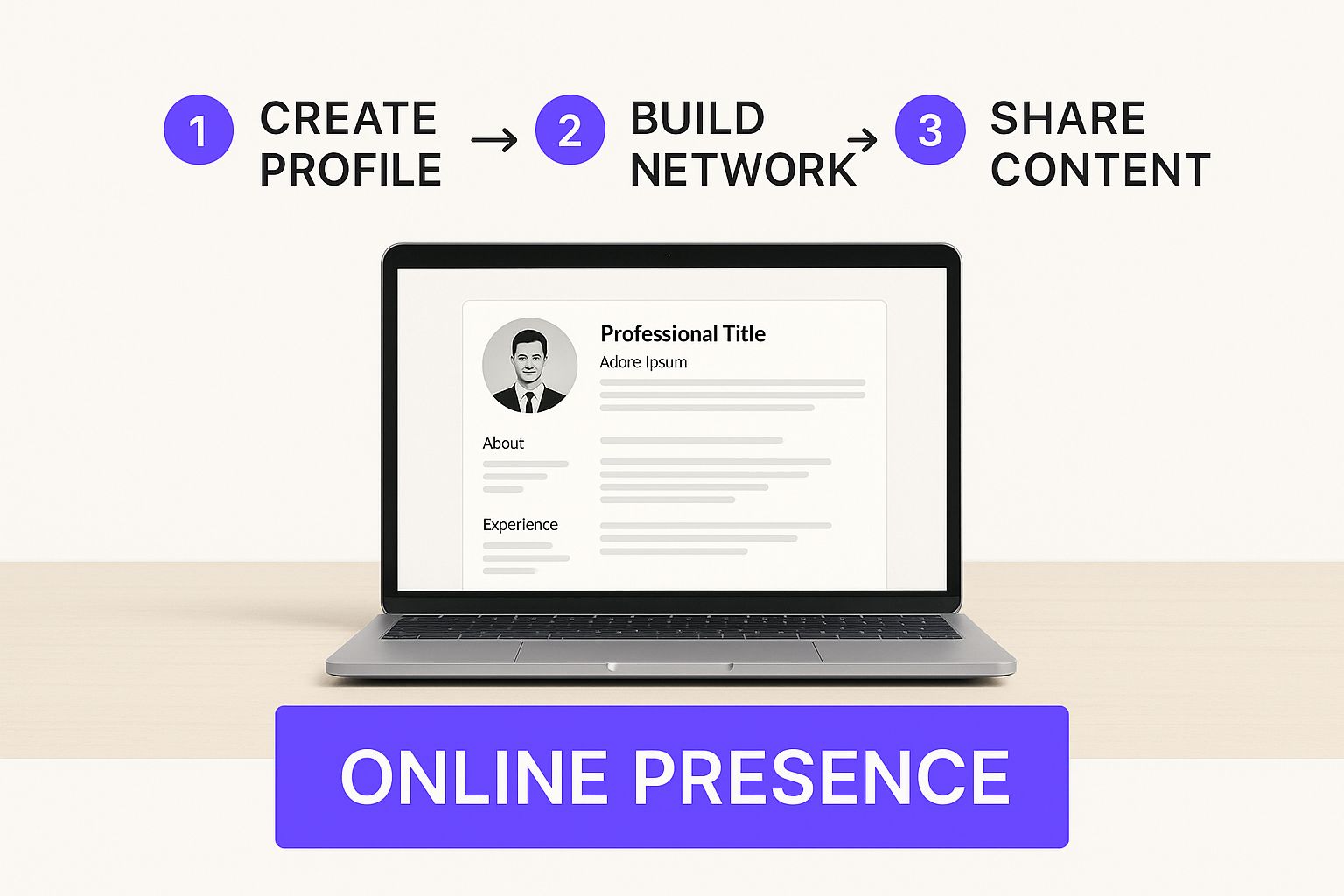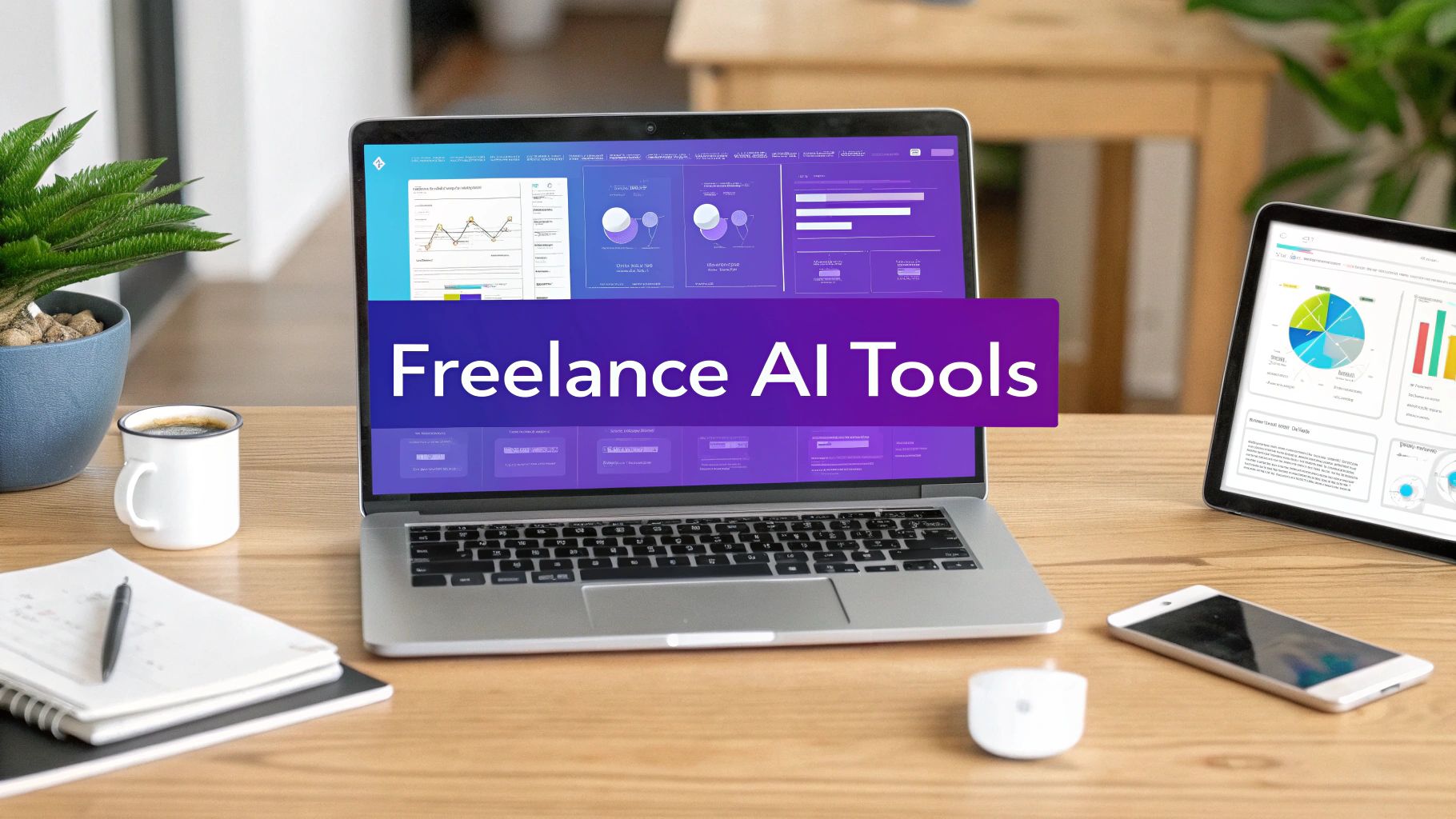How to Get Consulting Clients: Proven Strategies to Succeed

Finding your next consulting client doesn’t start with a sales pitch. It starts with building a solid foundation. Before you even think about outreach, you need to get crystal clear on who you’re trying to help and create a message that speaks directly to the results you deliver—not just the services you offer.
Getting this right from day one is the difference between casting a wide, empty net and having a magnetic pull on the right kind of clients.
Build Your Foundation to Attract High-Value Clients

You can't effectively find new business if you don't know who you're looking for. It’s a common mistake I see all the time: consultants spray and pray, hoping something sticks. That approach is a fast track to burnout and makes it nearly impossible to stand out.
The secret is to lay the groundwork so that client acquisition feels less like hunting and more like farming.
This process begins with one powerful decision: specialization. Instead of being a jack-of-all-trades, you need to plant your flag in a specific niche where your expertise will make the biggest splash. This could be a specific industry, a certain company size, or even a particular functional area within a business.
Pinpoint Your Ideal Client Profile
The more specific you are, the easier it becomes to find and connect with the right people. Start by asking yourself a few pointed questions to sketch out a detailed client avatar:
- Industry Focus: Where do you have deep knowledge? Think FinTech, healthcare, SaaS, or e-commerce. Don't be afraid to go narrow.
- Company Size: Do you thrive in the fast-paced world of startups? Or are you better suited for mid-market companies or large enterprises? Each has its own unique challenges and buying cycles.
- Decision-Maker: Who is the person with the budget who feels the pain you solve? Is it the CEO, a VP of Marketing, or a Head of Operations? Get specific.
For example, "all small businesses" is way too broad. A much sharper profile is, "Series A SaaS companies in the B2B space with 50-100 employees who need to fix their broken customer onboarding process." See the difference? That level of detail makes your marketing instantly relevant.
Craft a Compelling Value Proposition
Once you know exactly who you’re talking to, you have to nail why they should listen. Your value proposition isn’t a laundry list of what you do; it’s the tangible, bottom-line outcome you create for them. It must answer their unspoken question: "What's in it for me?"
A powerful value proposition moves beyond a list of services and communicates clear, measurable results. Focus on ROI, efficiency gains, or risk reduction—metrics that matter to decision-makers.
To truly pull in those high-value clients, you have to establish a credible, authoritative presence. This is where building a strong personal brand on LinkedIn becomes non-negotiable, as it puts your expertise directly in front of your target audience. You should also work to enhance your online presence across a few key platforms to build trust and authority long before you ever have a sales conversation.
The global strategic consulting market was valued at around USD 78.20 billion in 2024 and is projected to hit nearly USD 153.32 billion by 2032. This explosive growth signals a massive opportunity, but only for those consultants who can expertly tailor their skills to solve increasingly complex business challenges.
Chasing clients is exhausting. It’s a hamster wheel of cold calls and outreach that burns you out and rarely lands the high-value projects you really want.
Imagine, instead, that qualified leads come directly to you, already interested in your expertise. This is the power of a well-crafted inbound lead generation engine—a system that works around the clock to attract and pre-qualify potential clients. The idea is simple: stop selling and start demonstrating your value.
You do this by creating high-value content that solves the real-world problems your ideal clients face every single day. This positions you not as a salesperson, but as a trusted advisor.
The infographic below shows how a strong digital footprint, anchored by a professional profile, is central to attracting these inbound leads.

Think of your online presence as a digital storefront. Every piece of content you create is a signpost guiding potential clients right to your door.
Inbound vs. Outbound Client Acquisition Methods
Consultants typically rely on two primary methods for generating leads: inbound and outbound. Understanding the differences is key to building a sustainable client pipeline. While outbound has its place, a strong inbound strategy is what creates long-term, scalable growth.
Here’s a quick comparison of the two approaches:
| Method | Description | Pros | Cons |
|---|---|---|---|
| Inbound | Attracting clients through valuable content, SEO, and social media engagement. | Builds authority, attracts qualified leads, scalable, long-term asset. | Slower to build momentum, requires consistent effort. |
| Outbound | Actively seeking out clients through cold calls, emails, and direct outreach. | Can generate quick results, highly targeted. | Time-consuming, lower conversion rates, can feel intrusive. |
Ultimately, the most effective consultants blend both, but the goal should be to lean more heavily on inbound methods over time. This frees you up to focus on high-value client work instead of constantly hunting for the next project.
Become a Go-To Expert with Strategic Content
The goal isn’t just to create content, but to create the right content. You want to establish yourself as a thought leader—the first person prospects think of when they run into a problem you can solve.
Here’s where to focus your efforts for maximum impact:
- Insightful Blog Posts: Go beyond surface-level advice. Write in-depth articles that tackle a specific pain point. A cybersecurity consultant, for example, could write, "The Top 3 Unseen Security Risks for Mid-Sized E-commerce Stores in 2024."
- In-Depth Case Studies: Nothing proves your value like real results. A case study transforms your past work into a compelling story, showing a clear before-and-after. Frame it around the client's problem, your solution, and the measurable outcome (e.g., "How We Increased Lead Conversion by 45% for a SaaS Client").
- Practical Webinars: Webinars let you connect with an audience on a much deeper level. You can teach a specific skill or framework, demonstrating your expertise in real-time and answering questions. This builds immense trust.
Of course, your content needs to be discoverable. This means embedding basic SEO practices into your process. Use the keywords your clients are actually searching for, and focus on creating genuinely helpful resources that others will want to link to.
To really streamline this process and ensure a consistent flow of prospects, you might want to look into building an automated lead generation engine.
Use Social Platforms to Build a Community
For consultants, LinkedIn is so much more than a digital resume. When used correctly, it’s a powerful tool for building a community and positioning yourself as the go-to expert in your niche.
The secret to LinkedIn isn't just to post, but to engage. Join relevant group discussions, comment thoughtfully on others' content, and share your insights generously. Consistency is far more important than frequency.
Your profile itself is your primary landing page on the platform. It needs to speak directly to your ideal client, highlighting the problems you solve and the value you bring. If your profile is just a list of past jobs, it’s not pulling its weight.
Not sure where to start? Check out our guide on how to optimize your LinkedIn profile to turn it into a client-attraction machine.
By consistently sharing valuable content and engaging with your network, you create a magnetic presence. Over time, you'll shift from hunting for clients to having them come to you, ready for a conversation. This is how you build a sustainable and scalable consulting business.
Master Strategic Networking and Outreach

While building an inbound engine is your long-term play for sustainable growth, you can’t just sit around waiting for the phone to ring. Strategic networking and targeted outreach are how you land consulting clients right now. This isn't about spamming inboxes with awkward sales pitches; it's about making genuine connections that actually lead somewhere.
The trick is to stop thinking like a salesperson and start acting like an expert who helps people. Your goal isn't to close a deal on the first call. It's to start a conversation, show you know your stuff, and build enough trust that when a problem pops up, you're the first person they think of. This proactive approach will fill your pipeline much faster than waiting for your content to rank.
Tap Into Your Existing Network First
Your fastest path to a paying client is almost always through people who already know, like, and trust you. This "warm" network is your most valuable asset, especially when you're just starting out or need to fill a gap in your project schedule.
Think about it. Former colleagues, past managers, and even connections from previous jobs have seen your work up close. They know your skills and your work ethic. Reaching out to them isn't a cold pitch—it's just catching up.
Here’s a simple, non-salesy way to do it:
- Send a personalized message. Let them know you've launched your own consulting practice.
- Be crystal clear about the problem you solve. For instance, "I'm now helping B2B SaaS companies slash customer churn with smarter onboarding."
- Make a simple offer to help. Something like, "If you know anyone struggling with this, I'd be happy to chat," works wonders.
This kind of outreach keeps you top-of-mind and quietly turns your network into a referral machine. With the U.S. management consulting market projected to hit USD 404.1 billion in 2025, you need every advantage you can get. Building credibility through trusted connections is how you carve out your piece of that pie.
The Art of the Referral
Referrals are the gold standard for landing new clients. Why? Because they come with built-in trust. When someone you respect recommends a consultant, most of the usual skepticism just melts away. Yet, so many consultants are too shy to ask for them.
Don’t just wait for referrals to fall into your lap. The best time to ask is right after you’ve delivered amazing results or a client gives you great feedback. They're happiest with your work in that moment and most likely to become your advocate.
A simple script can make this conversation feel much more natural:
"I'm so glad you're happy with the results! I'm looking to help a few more companies solve similar challenges. Do you know anyone else in your network who might be struggling with [the problem you just solved]?"
This approach is direct but professional. It frames your ask around helping others, not just lining your own pockets.
And for those moments when you need to expand your reach beyond your immediate circle, you have to get good at making new connections from scratch. Our guide on how to network online effectively is packed with practical tips for building valuable professional relationships in the digital world.
Crafting Proposals That Actually Win Contracts
Getting a potential client to agree to a meeting is a huge win, but it’s not the finish line. The proposal is your final, most critical sales document—it’s where the conversation shifts from “what if” to “how.” A great proposal does more than just list services; it builds confidence and makes saying ‘yes’ feel like the most logical next step.
So many consultants get this wrong. They send over a glorified price list, focusing on their activities and hours instead of the client's desired outcome. That approach forces the client to guess at the value you bring, which is a fast track to losing the deal. A winning proposal is a strategic document that closes the gap between their problem and your solution.
It needs to scream, "I listened, I get it, and here's exactly how we'll get you the results you need."
Frame Your Solution Around Value
The best proposals are never about you; they are 100% about the client. Your job is to translate your services into tangible business outcomes they can get excited about. Instead of saying, “I will conduct 10 hours of market analysis,” frame it as, “We will identify your top three untapped market opportunities to drive a projected 15% revenue increase.”
See the difference? This simple shift from activities to outcomes is everything. It changes the client's focus from your cost to their potential ROI. Every single section of your proposal should echo this value-driven story.
Your proposal isn't a cost-benefit analysis of hiring you. It's a business case for solving the client's problem. Frame every deliverable in terms of the value it creates for their organization.
To really nail this, I always start my proposals by restating their problem in my own words. It’s a powerful way to show you were paying attention and to validate their challenges. Only after you’ve established that shared understanding of the problem should you introduce your solution and its direct impact.
Choosing the Right Pricing Model
How you price your services speaks volumes about the value you provide. While hourly rates are easy to calculate, they often penalize you for being efficient and put a hard cap on your earning potential. If you want to land clients who value results, you need to present pricing that reflects the outcome.
Here are three common models I've used and when they work best:
- Project-Based Fee: This is a flat fee for the entire project. Clients love it because it gives them cost certainty. It's the perfect model for projects with a clearly defined scope and endpoint, like developing a new marketing strategy or implementing a software system.
- Monthly Retainer: A retainer basically puts you on call, securing your availability for a set number of hours or ongoing support each month. This is ideal for long-term advisory roles or when a client needs continuous access to your brain for things like maintenance, optimization, or strategic guidance.
- Value-Based Pricing: This is the most advanced model, where your fee is a percentage of the value you create (e.g., a percentage of cost savings or new revenue generated). It directly ties your pay to the client’s success, making it an incredibly powerful option for projects with clear, high-impact financial outcomes.
A strong proposal leaves no room for doubt. It clearly outlines the problem, presents a value-focused solution, details the scope and deliverables, provides a realistic timeline, and presents pricing that aligns with the results. Make it an easy "yes" for them to sign on the dotted line.
Find Your Edge with Specialization and Technology
In a sea of generalist consultants, one of the fastest ways to get lost is to try and be everything to everyone. When potential clients can't figure out exactly what you do, they default to the one thing you don't want to compete on: price.
The fix? Specialization. When you carve out a niche and become the go-to expert, something shifts. You stop chasing clients, and they start looking for you.
This focus simplifies everything. Your marketing is no longer a shot in the dark; it's a laser-focused message aimed at a specific group with a shared, painful problem. A proposal for "supply chain optimization for mid-sized CPG brands" hits a lot harder than one for "general business consulting." Suddenly, you’re not just a consultant; you are the consultant for their exact needs.
Find and Own Your Profitable Niche
Choosing a niche isn't about closing doors; it's about opening the right ones. A sharp specialty allows you to build deep, undeniable expertise, which in turn lets you create hyper-relevant content and command premium rates. You're not just solving a problem; you're solving a high-value one that few others can.
Think about specializing in one of these ways:
- By Industry: Zero in on a sector you know inside and out, like FinTech, healthcare, or renewable energy. Your intimate knowledge of the industry's unique regulations, trends, and headaches becomes your biggest asset.
- By Service: Become a master of a specific discipline, like change management, digital transformation, or data analytics. You'll become so good that other, larger firms might even bring you in as a subcontractor.
- By Audience: Tailor your services for a specific type of client, like venture-backed Series B startups or family-owned manufacturing businesses.
The global consulting market was valued at roughly USD 263.25 billion in 2024 and is projected to hit USD 421.2 billion by 2033. The biggest drivers? Digital transformation and operational efficiency. Positioning yourself in a high-demand area like these gives you a real shot at grabbing a piece of that massive, growing pie.
Build Your Essential Tech Stack
Once your niche is locked in, technology is what gives you leverage. The right tools don't just make you more efficient; they help you deliver a seamless, professional experience from the first conversation to the final invoice. A solid tech stack isn't a "nice-to-have"—it's the backbone of any modern consulting practice that plans to scale.
A well-curated tech stack automates the grunt work, freeing you up to focus on what clients actually pay you for: delivering exceptional results. It’s what separates the pros from the amateurs.
Your core stack should cover a few key areas:
- Client Relationship Management (CRM): You don't need anything complicated. A simple CRM like HubSpot or Pipedrive is perfect for tracking leads and conversations so a promising opportunity never slips through the cracks.
- Project Management Tools: Platforms like Asana, Trello, or Monday.com are non-negotiable. They keep projects on track, communication transparent, and deadlines met. This level of organization builds incredible trust with clients.
- Communication and Collaboration: Slack and Zoom are the industry standard for a reason. They keep communication lines open and efficient, both with your team and your clients.
When you combine a razor-sharp niche with smart technology, you transform from just another consultant into a high-demand, specialist powerhouse. For more strategies on building a system that consistently brings in new business, check out our guide on how to attract clients.
Of course. Here is the rewritten section, designed to sound like it was written by an experienced human expert, following all the provided style and formatting guidelines.
Common Questions on Finding Consulting Clients
Even with the best game plan, a few questions always seem to pop up when you're trying to land consulting clients. It's totally normal to second-guess yourself. Let's tackle some of the most common hurdles I see consultants face, so you can move forward with more confidence.
Think of this as a quick chat to clear up any lingering doubts and get you back on track to building your client roster.
How Long Until I Land My First Client?
There's no magic number here, but I've seen most new consultants land their first paying client within 1 to 6 months of consistent, focused work. A few things can speed this up or slow it down: the strength of your existing network, how laser-focused your niche is, and just how much you're putting yourself out there.
If you want to fast-track this, start with the lowest-hanging fruit—your existing network. Those warm connections and referrals are your quickest path to getting paid. While building out a content strategy is fantastic for long-term, sustainable business, it simply takes too long to get traction when you need cash flow now.
What Is the Best Method for a New Consultant?
When you're just starting out, the most practical approach is a one-two punch: targeted outreach combined with activating your warm network. Again, while a solid content engine is a crucial long-term asset, you need to generate revenue today, not six months from now.
Here’s what that looks like in the real world:
- Targeted Outreach: Make a list of 50 companies that are a perfect fit for what you do. Find the right decision-makers on LinkedIn and send them a highly personalized email. The key is to focus on the specific, tangible value you can bring to their business.
- Network Activation: At the same time, reach out to your former colleagues, managers, and professional contacts. Let them know you're consulting, but don't be vague. Tell them exactly what kinds of problems you solve so they can easily spot a potential referral for you.
I’ll bet your first great client comes from a warm referral. The people who already know you, trust your work, and can vouch for you are your most powerful allies. They can slash the sales cycle in half.
Building that network is an ongoing process, not a one-time task. For some practical tips on keeping your pipeline full, you can learn how to increase LinkedIn connections and grow your professional circle.
How Should I Price My Services for Early Clients?
Whatever you do, resist the urge to charge by the hour. It's a trap. Hourly billing punishes you for being efficient and puts a hard cap on what you can earn. From day one, you should be thinking in terms of project-based or value-based pricing.
Start by doing some homework. See what the market rates are for your niche and experience level to get a ballpark figure. It's okay to offer a small discount for your first client or two in exchange for a killer testimonial and a portfolio piece. But be careful not to devalue yourself too much—it sets a bad precedent that's hard to break later.
A fixed project fee is a great place to start. It gives your client the cost certainty they need and ensures you're paid fairly for the outcome you deliver, not just the hours you put in.
Ready to stand out and attract high-value clients effortlessly? MakerBox uses AI to create an optimized professional presence for you in seconds. Transform your profiles, generate engaging content, and build the credibility you need to win more consulting contracts. Elevate your professional brand with MakerBox today.





